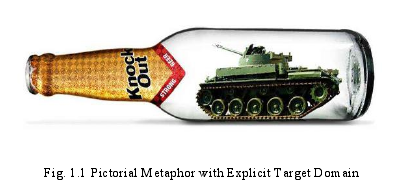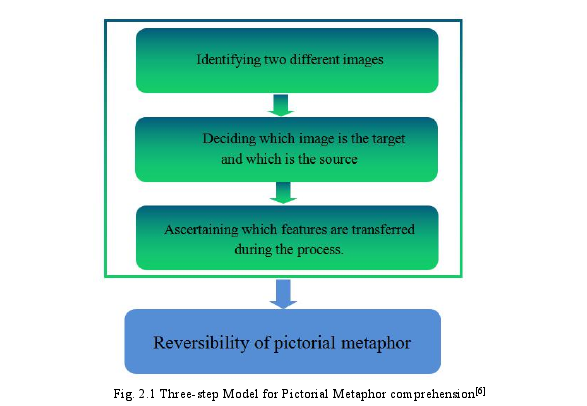本文是一篇英语论文,本研究最重要的贡献在于发现,尽管反向隐喻和正向隐喻的理解存在差异,但可逆性确实存在于隐喻理解中,这意味着可逆性只在条件下发生。与CMT认为隐喻中两个域之间的映射是基于单向投射的观点相比,本研究指出,对于图像隐喻而言,两个域概念之间的双向关联可能是隐喻形成和理解的初始阶段,在单向投射之前。这种时间优势可以用图像优势效应来解释,它为超视距解释提供了更广泛、更快的可能性。实验中使用的句法标记也可以解释这个结果。
1.Introduction
1.1 Research Background
Metaphor is a topic, long and widely discussed in academia. Lakoff and Johnsonproposed the conceptual metaphor theory, which holds that metaphor is a systematic mappingfrom a specific conceptual domain to an abstract conceptual domain[1]. This means thatmetaphor involves a mental processing which can be reflected not only in language but also inother modalities. Since then, research on metaphor have shifted from language to othermodalities. For example, Forceville put pictorial metaphor (PM) into the framework ofcognitive linguistics[2]. Cohn studied comics as visual language under the frame of linguisticanalysis[3]. And the text-image relation in political cartoons was also studied, such as that byBergen[4].
On the other hand, the global advertising expense has reached $ 600 billion, and it hasbecome a common phenomenon that print ads use rhetorical figures, of which metaphor is thebest known example. About advertising metaphor the central topic involves viewers’identifying the target and the meaning intended by the advertisers. This two-step cognition isclosely related to the reversibility of pictorial metaphor (or direction). If a metaphor isreversible, it means that there exists an accepted order of both “A is B”, and “B is A”[5]. It canalso be expressed as the identification of the target and the identification of the transferredfeatures of pictorial metaphors[6-10]. For example, it seems easy to identify the target andtransferred features in Figure 1.1. This advertisement is about the product “beer” rather thanthe “tank”, and it can be expressed as “beer is as strong as the tank”. But it seems difficult toidentify the target object in Figure 1.2. Viewers may wonder whether the advertisement themeis about the “tie” or the “chocolate”. In comparison, the verbally- presented feature “strong”of the “tank” made the choice of the target and source justified in Fig 1.1.

....................................
1.2 Research Objectives and Significance
In the research of pictorial metaphors, a metaphor, academically defined, alwayscompares two different objects: one is the target object and the other is the source object.From the practical perspective, viewers depend on shared information to yield positive effectssuch as purchase desires. One of the premises to achieve this expected intention is improvingviewers’ comprehension and liking towards the advertisements to trigger viewers’ interest sothat they may exchange active interpretations after being exposed to the advertisements. Thisassumption has led scholars to study such issues as how viewers identify and confirm thetarget objects, what factors will influence the choice, the extent to which they appreciateadvertising and how they can compromise a balance between advertisement comprehensionand advertisement liking.
In order to clarify the comprehension processing mechanism, several factors whichinfluence the outcomes have been identified. Among the diverse influencing factors for theprocessing of advertising pictorial metaphors, individual comprehension, aptness, familiarity,involvement, visual structure of pictorial metaphor, verbal clues, and (a)symmetry are themost important.
Based on all the above, this paper aims to study the reversibility in the processing ofpictorial metaphors by observing the influencing factors of aptness, (a)symmetry, and verbalfeatures, with other factors controlled. Three research questions will be answered:
(1) Does there exist the reversed processing of pictorial metaphors? (Experiment One,with a focus on aptness)
(2) In real advertisement context, given comprehension and advertisement liking, whatis the effect of (a)symmetry on reversibility? (Experiment Two, with a focus on (a)symmetry)
(3) What is the effect of verbal clues on reversibility in real advertisement context?(Experiment Three, with a focus on verbally- presented features)
.........................
2. Literature Review
2.1 Metaphor in Advertisement
From the conceptual metaphor theory by Lakoff and Johnson that metaphor is not merelya linguistic device used figuratively in poems and literature but a conceptual process thatplays an important role in cognition[1], it can be learned that language is the externalmanifestation of conceptual metaphor.
In recent years, in addition to verbal representation of conceptual metaphors, metaphorresearch in other modalities were carried out, for example, the leading scholar of multimodalmetaphors, Forceville[2], first put pictorial metaphor into the framework of cognitivelinguistics, and then research on metaphor has extended to many different fields, includingmetaphors in political cartoons[17], TV commercials[18], films[19] and editorial cartoons[20].Lagerwerf, Van, and Korenberg proposed that pictorial metaphors were based on theconnection of two different objects, the essence of which was to “express the present thing(target) with another thing (source)”[21]. Concerning a pictorial metaphor, it was important todecide which was the target and which was the source, and this identification was related tomany factors. Forceville analyzed the phenomenon of pictorial metaphor in print advertising,proposing a three-step model of pictorial metaphor analysis, including the identification oftwo images, determining which image as the target and which as the source, as well asjudging transferred features[6]. This process was closely related to the reversibility of pictorialmetaphors (see Fig. 2.1).

2.2 Theories Related to Pictorial Metaphors
Advertising pictorial metaphor, as an emerging research field of pictorial metaphor, hasdrawn wide attention. Three theories are the most widely used, notably, the multimodalmetaphor theory, structure- mapping theory, and the conceptual blending theory.
2.2.1 Multimodal Metaphor Theory
Xie[47]and Forceville[48] made a distinguished difference between mono-modal metaphorsand multimodal metaphors. In a multimodal metaphor the source and target domain wererepresented exclusively in different modes. According to Forceville[6], in a pictorial metaphor,when an expected visual element could be replaced with an unexpected visual element, therewas not necessarily a “pre-exist or conventional link” between the two elements. Based onthis idea, Rosa put forward a three-dimensional model for comprehending a pictorialmetaphor[49], the first step is to perceive the pictorial context, which depicts the basic contextthat the viewer will be working with, then to comprehend the linguistic message which willhelp the viewer recognize the intended meaning, and the third step is to refer to the worldknowledge which enriches the information put together by applying a wider context imposedby the pictorial metaphor. The three dimensional model emphasizes the influencing factors inthe processing of pictorial metaphors.
2.2.2 Structure- Mapping Theory
Structure- mapping theory, proposed by Gentner in 1988[13], claims that the informationfor metaphor comprehension is much richer and more complex than the knowledgerepresentation assumed in the previous analog model. In particular, knowledge of complexmetaphorical situations usually involves the features of individual object and the relationshipsbetween the two objects.
3. Experiment One: Reversibility and Aptness.................................20
3.1 Pretests.....................................20
3.1.1 Aptness and Familiarity..............................................20
3.1.2 Feature Generation Task...........................................21
4. Experiment Two: Reversibility and (A)symmetry.................................... 29
4.1 Pretests.................................29
4.2 Participants and Materials.......................................29
5. Experiment Three: Reversibility and Verbal Features.............................34
5.1 Pretests...................................34
5.2 Participants and Materials......................................34
6. Discussion
6.1 Existence of Reversibility in Pictorial Metaphors
Hypothesis One that intended to find reversibility in processing pictorial metaphor issupported. In the first experiment, the participants judged paired object pairs in fourconditions to be comprehensible or not. The four conditions were literal true statement,forward metaphor, reversed metaphor, and scrambled metaphor.
It was noticeable in the study that there was an apparent difference between forwardmetaphors and reversed metaphors in terms of comprehension, indicating a preferred directionfor the comprehension of pictorial metaphors. This finding was in line with the study of Kressand Van Leeuwen[112], who proposed that pictorial metaphor could not be reversed due to adistinction between the “given” and the “new” images placed next to each other. This meantthat there was a visual grammar for comprehending pictorial metaphors.
However, it was also strongly shown in this study that there was reversibility for pictorialmetaphor comprehension. Compared to forward metaphor, the reversed metaphor wasprocessed for comprehension too, even though not completely. Both forward and reversedmetaphors were different from the baseline of literal true statement. This finding implies thatthey are both easier to be comprehended than scrambled metaphors and more difficult thanliteral true statements, which indicates that metaphorical understanding is possible in bothdirections for pictorial metaphors. And this is consistent with the claim of structural mappingtheory that metaphor comprehension involves two stages, including seeking commonalitiesand directional mapping[30-31][113-116]. According to structure-mapping theory, there are twostages during metaphor comprehension, and in the present study, we tested whether there is atendency of reversibility based on the time line. The study didn’t focus on the accurate timewhen the stage of commonality starts to shift to the directional stage, as Wolff and Gentnerdid[31]. They set two time points to test two different views of symmetric alignment anddirectional phase. This present study has proved that even at one single time point the resultscan still clearly show the two processes of metaphor comprehension, given both directionscan be processed by participants, and there is a striking difference for the comprehension ratebetween forward metaphors and reversed metaphors.
7. Conclusion
7.1 Major Findings
The most important contribution of the study is the finding that reversibility does exist inmetaphor comprehension, despite a difference of the comprehension between the reversed andforward metaphors, which means that reversibility only occurs conditionally. Compared withthe CMT claiming that the mapping between two domains in a metaphor is based on one-direction projection, this study points out that for pictorial metaphors the bidirectionalassociation between concepts from two domains may be the initial phase of metaphorformation and comprehension, preceding unidirectional projection. This temporal advantagecan be explained by the picture superiority effect that opens a wider and quicker possibility ofmetaphor interpretation. The syntactic marker used in the experiment may also account forthis result.
The second significance of this study lies in that it explored and verified threeinfluencing conditions. First, in terms of the relationship between the target and the source,the aptness of pictorial metaphor influences the reversibility. Pictorial metaphors of highaptness are easier to be comprehended and appreciated compared to those of low aptness. Inaddition, in the real advertising context, (a)symmetry considering how the target- sourceobjects are presented can lead to varied degrees of reversibility. Asymmetrical pictorialmetaphors are less reversible and easier to be processed. At last, from the perspective ofcontextual clues, verbally-presented features also play an important role in reversibility, withsource features and shared features having a more significant effect than target features.
reference(omitted)
